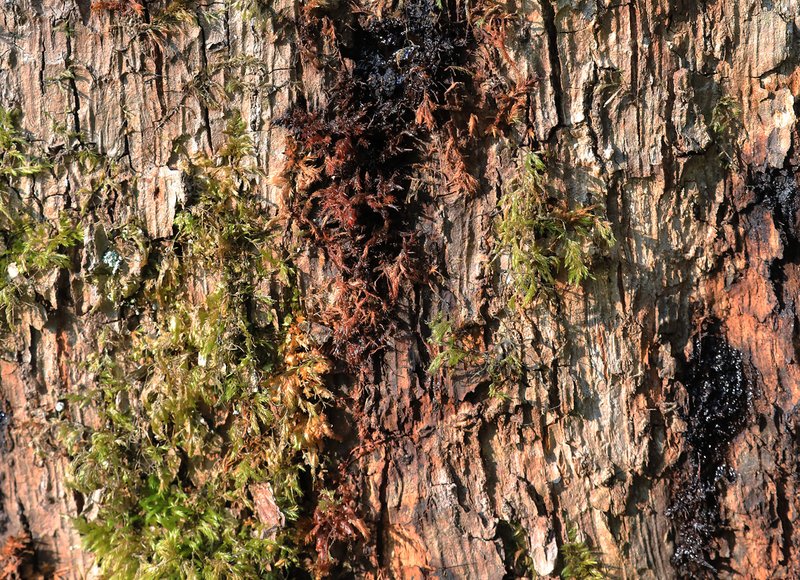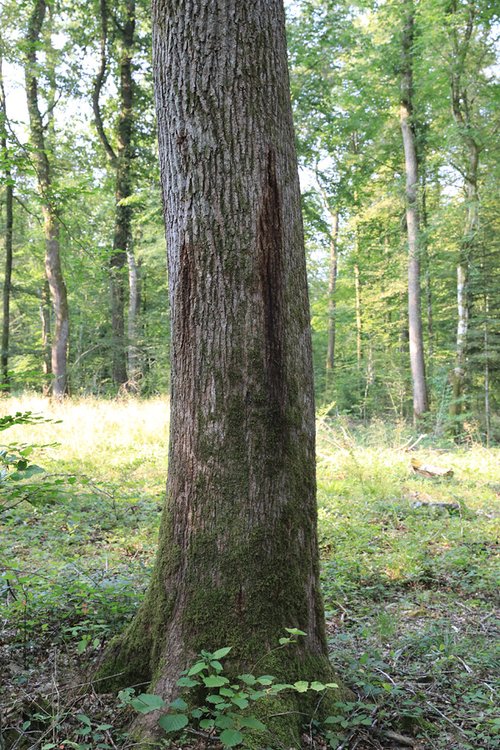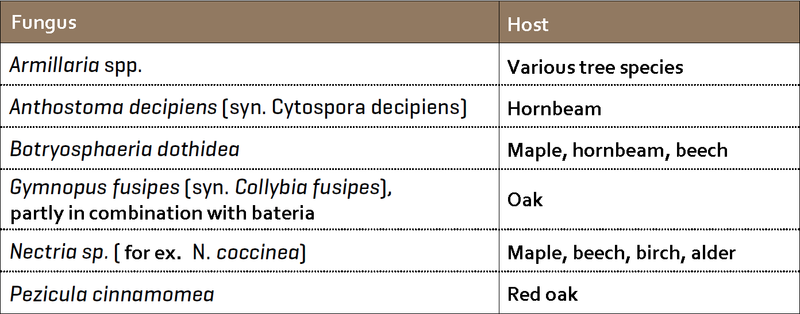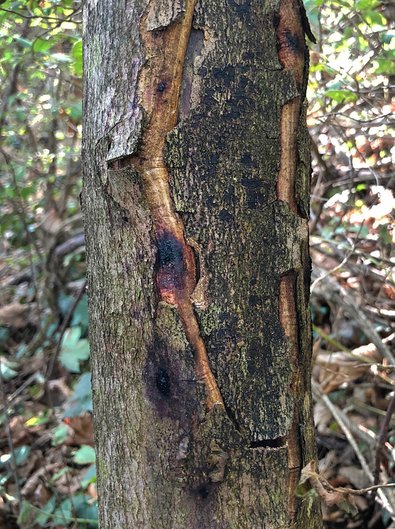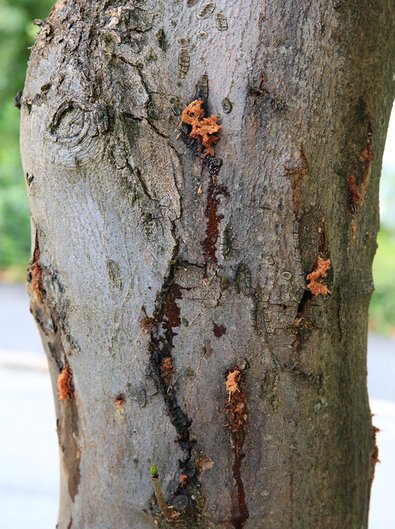Moisture leaking from trees is not uncommon in forests. It is now clear that, in most cases, complex pathogens are involved. However, the various modes of action are far from being fully uncovered. Our understanding of this pathology is developing all the time.
Bark exsudation (Figure 1) is triggered by various modes. While some organisms are the sole cause in an infection, bacteria seem to be involved in many other cases. When bacteria get under tree bark, they multiply and ferment, softening the wood and producing carbon dioxide. This gas creates pressure in the wood, the sap is forced through cracks to the surface, where numerous microorganisms settle and cause it to become more viscous and slimy as they multiply.
The relevance of abiotic stress such as drought, frost or heat as a factor that increases trees' susceptibility to disease is increasingly being recognised. Bacteria are also more frequently detected as pathogens. On the whole, an interplay of different factors and harmful organisms is becoming apparent, as is typical for complex pathogens. However, how exactly the factors interact is not yet fully understood. Bark exsudation is one of many symptoms here.
Swiss Forest Protection has been investigating cases of bark exsudation for several years. While Phytophthora species were identified as the sole cause of some cases, bacteria were also found to be involved in many others (Table 1).
Table 1 - Tree species on which Swiss Forest Protection has observed bark exsudation in recent years and causative biotic factors.
Bark exsudation on horse-chestnut and walnut trees was clearly due to bacterial infections. On the horse chestnut, it was caused by Pseudomonas syringae pv. aesculi, which occurred partly in combination with Phytophthora species. Whether and how exactly the two species interact is not known.
Xanthomonas arboricola pv. juglandis was the cause of bark exsudation affecting walnut. Interestingly, the two bacterial genera Brenneria sp. and Erwinia sp. were also found. These also appear on some oaks with bark exsudation. It is as yet unclear whether the genera occur in walnut trees as secondary colonisers or are the cause of the symptoms. In some cases (e.g. involving sycamores), abiotic factors also contributed to the development of the symptoms.
Based on the cases documented by Swiss Forest Protection, the various causes of bark exsudation are discussed below.
Phytophthora
Various Phytophthora species are known to cause bark exsudation. These include P. plurivora, P. cambivora, P. cactorum, P. cinnamomi and P. ramorum, the last of which is a non-native quarantine organism known to have caused sudden oak death (SOD) in the USA. In Switzerland, no cases of P. ramorum on oaks have been observed to date; it has mainly affected ornamental shrubs of the genera viburnum (snowball) and rhododendron in nurseries. However, bark exsudation on oaks is not always synonymous with a Phytophthora infection. Bacteria can also be the cause.
Bacteria
In Switzerland, the bacteria Brenneria goodwinii, Gibbsiella quercinecans and Rahnella victoriana were detected on sessile oaks for the first time in spring 2017 (more information is available in German here). The isolated bacteria, which were first observed in the UK in 2008, are associated with acute oak decline (AOD), which is not to be confused with SOD (Table 2).
Thanks to a molecular detection method, specialists at the Swiss Federal Institute for Forest, Snow and Landscape Research (WSL) can now quickly and reliably detect infections caused by the three bacteria, allowing them to identify further infections on common and downy oaks, as well as red oaks. While these bacteria were first found on planted oaks in Switzerland, they were subsequently detected on naturally regenerated trees in forests.
Table 2: Differences between sudden oak death and acute oak decline
Dark bark exsudation and vertical cracks with dead, weeping wood under the bark are signs of bacterial contamination (Figure 2). The diseased trees are mostly, but not exclusively, mature oaks. Only in the advanced stage do they exhibit crown transparency as the crown dies branch by branch.
The bacteria on their own would probably not kill the oaks. Rather, it is the combination with other factors that lead to the death of a tree. Such factors include injuries to the trunk, desiccation, frost, strong fluctuations in environmental factors in general, or colonisation by secondary pests.
While certain types of Phytophthora can attack healthy trees, the bacteria B. goodwinii, G. quercinecans and R. victoriana likely infect already weakened trees and so accelerate a gradual decline in vitality. It is therefore a complex disease to which biotic and abiotic factors contribute. This is also supported by studies from the UK, which identify a connection between the bacteria and the two-spotted oak buprestid (Agrilus biguttatus). This beetle is also native to Switzerland but rarely causes damage. The exact connection is not yet fully understood.
Another study showed (by means of inoculation tests, i.e. the deliberate introduction of pathogens) that the bacteria G. quercinecans and B. goodwinii cause bark exsudation. The role played by R. victoriana is as yet unclear. Furthermore, the involvement of other bacterial species cannot be excluded.
A systematic observation of healthy and diseased trees is key to ensuring a thorough risk assessment of symptoms affecting oaks. Overall, there are growing reports of the three bacteria on the European continent. This raises the question of whether they are indigenous or non-native organisms. Reports of the bacteria in a practically untouched forest area and the considerable similarity between the symptoms observed today and those described as early as 1995 suggest that the bacteria have been present in Switzerland for some time. However, further investigation is necessary to clarify this question.
Other causes
Many of these pathogens do not cause a fatal disease on their own unless other adverse factors are involved. Abiotic factors such as drought stress, frost or heat make a tree susceptible to colonisation by harmful organisms and to subsequent disease.
Beech bark necrosis is known to occur in beech trees. The complex of causes includes biotic factors (Nectria coccinea, Cryptococcus fagisuga) as well as droughts that have a negative effect on the water balance. The disease is not always fatal for the tree.
Disease-promoting abiotic factors can also encourage Pezicula cankers on red oaks and symptoms of Anthostoma decipiens. On maples, a Nectria fungi infestation combined with abiotic pre-existing damage can cause bark exsudation (Figure 3). Partial tree bark dieback caused by Nectria sp. with bark exsudation occurs in maple as well as beech, birch and alder.
In addition to the fungi mentioned, fireblight bacteria (Erwinia amylovora) can also cause bark exsudation. Rowan, hawthorn and cotoneaster are just some of the species affected. Bark exsudationis also one of the possible attendant symptoms of wet heartwood. Dark, very wet patches in the heartwood and inner sapwood are always associated with bacteria. On trees with extensive wet heartwood, moisture sometimes leaks out through cracks in the bark.
Boring by insects, such as the beech bark beetle (Taphrorychus bicolor), the poplar borer (Saperda calcarata) and Cryptorhynchus lapathi on poplar and willow trees, is another possible cause of bark exsudation, as bacteria and fungi can enter the tree through the holes created by these insects (Figure 4).
Conclusion
Complex diseases are becoming more widespread. These are syndromes resulting from biotic and abiotic factors, the harmful effects of which arise from successive, combined and mutually reinforcing occurrences. The course and intensity of such diseases are influenced by complex interactions between the individual organisms involved, but also between abiotic factors and the organisms. There is often still little in the way of research into such complex diseases, and starting points for management strategies are lacking.

